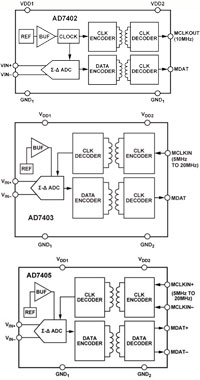 The AD7402, AD7403, and AD7405 are high performance, second-order, Σ-Δ modulators that convert an analog input signal into a high speed, single-bit data stream with on-chip digital isolation based on ADI's iCoupler® technology. The modulators operate from a 4.5 to 5.5 V (VDD1) (AD7402) power supply or from a 5 V (VDD1) (AD7403/AD7405) power supply. The modulators accept a differential input signal of ±250 mV (±320 mV full scale). The differential input is ideally suited to shunt voltage monitoring in high voltage applications where galvanic isolation is required.
The AD7402, AD7403, and AD7405 are high performance, second-order, Σ-Δ modulators that convert an analog input signal into a high speed, single-bit data stream with on-chip digital isolation based on ADI's iCoupler® technology. The modulators operate from a 4.5 to 5.5 V (VDD1) (AD7402) power supply or from a 5 V (VDD1) (AD7403/AD7405) power supply. The modulators accept a differential input signal of ±250 mV (±320 mV full scale). The differential input is ideally suited to shunt voltage monitoring in high voltage applications where galvanic isolation is required.
The analog input is continuously sampled by a high performance analog modulator and converted to a ones-density digital output stream with a data rate of 10 MHz (AD7402) or 20 MHz (AD7403/AD7405). The original information can be reconstructed with an appropriate digital filter to achieve 87 dB signal to noise ratio (SNR) at 39 kSPS (AD7402) or 88 dB signal-to-noise ratio (SNR) at 78.1 kSPS (AD7403/AD7405). The serial input/output can use a 3 V to 5.5 V or a 3.3 V supply (VDD2) (AD7402) or 5 V or a 3 V supply (VDD2) (AD7403). The LVDS input/output can use a 5 V or a 3.3 V supply (VDD2) (AD7405).
The serial and LVDS interfaces are digitally isolated. This combined with monolithic transformer technology, means the on-chip isolation provides outstanding performance characteristics; superior to alternatives such as optocoupler devices. The AD7402 and AD7403-8 devices are offered in an 8-lead wide body SOIC package and have an operating temperature range of -40°C to 105°C. The AD7403 and AD7405 devices are offered in a 16-lead, wide-body SOIC package and have an operating temperature range of -40°C to 125°C.
| Features and Benefits |
|
|
- 10 MHz internal clock rate (AD7402)
and 5 MHz to 20 MHz external clock input rate (AD7403/AD7405)
- 16-bits; no missing codes
- Signal-to-noise ratio (SNR): 87 dB typical (AD7402) and 88 dB typical (AD7403/AD7405)
- Effective number of bits (ENOB): 13.5 bits typical (AD7402) and 14.2 bits typical (AD7403/AD7405)
- Typical offset drift vs. temperature: 1.7 µV/°C (AD7402), 1.6 μV/°C (AD7403/AD7405), 2 μV/°C typical (AD7403-8)
|
|
- Serial (AD7402/AD7403) and LVDS (AD7405) interfaces
- On-board digital isolator
- On-board reference
- Full-scale analog input range: ±320 mV
- -40°C to 105°C (AD7402/AD7403-8) and -40°C to 125°C (AD7403/AD7405) operating ranges
- High common-mode transient immunity: >25 kV/μs
- 8-lead (AD7402/AD7403-8) and 16-lead (AD7403/AD7405), wide-body SOIC, with increased creepage package
|
| Applications |
|
|
- Shunt current monitoring
- AC motor controls
- Power and solar inverters
|
|
- Wind turbine inverters
- Data acquisition systems
- Analog-to-digital and opto-isolator replacements
|
 The AD7402, AD7403, and AD7405 are high performance, second-order, Σ-Δ modulators that convert an analog input signal into a high speed, single-bit data stream with on-chip digital isolation based on ADI's iCoupler® technology. The modulators operate from a 4.5 to 5.5 V (VDD1) (AD7402) power supply or from a 5 V (VDD1) (AD7403/AD7405) power supply. The modulators accept a differential input signal of ±250 mV (±320 mV full scale). The differential input is ideally suited to shunt voltage monitoring in high voltage applications where galvanic isolation is required.
The AD7402, AD7403, and AD7405 are high performance, second-order, Σ-Δ modulators that convert an analog input signal into a high speed, single-bit data stream with on-chip digital isolation based on ADI's iCoupler® technology. The modulators operate from a 4.5 to 5.5 V (VDD1) (AD7402) power supply or from a 5 V (VDD1) (AD7403/AD7405) power supply. The modulators accept a differential input signal of ±250 mV (±320 mV full scale). The differential input is ideally suited to shunt voltage monitoring in high voltage applications where galvanic isolation is required.









































